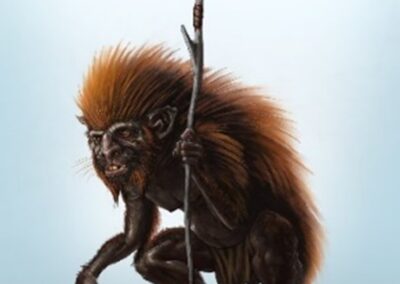Pukwudgie: Mischievous Spirit or Nature’s Guardian?
There’s something both eerie and enchanting about the deep forests of New England. Maybe it’s the morning mist curling through the trees, or the centuries-old stories echoing between the trunks. One such story that has lingered through time is that of the Pukwudgie — a small, mysterious creature rooted in the folklore of the Wampanoag Nation.
But who — or what — are Pukwudgies, really? Are they malevolent tricksters out to harm humans, or misunderstood spirits of the land? I recently dove headfirst into centuries of legends, beliefs, and even modern-day sightings to try and understand these elusive beings.
What Exactly Is a Pukwudgie?
According to Wampanoag lore, Pukwudgies are small humanoid creatures, usually about 2–3 feet tall, with gray or brownish skin, large ears, and sharp teeth. Sometimes they appear almost goblin-like, with animalistic features, while other times they’re more human in form, albeit with exaggerated fingers and noses. Some accounts even describe porcupine-like quills sprouting from their backs.
The name “Pukwudgie” translates to “person of the wilderness,” which adds an interesting layer to their mythology. They’re not just monsters hiding in the woods — they’re part of the land itself.
The Origins: More Than Just Myth
Pukwudgies didn’t start as cryptids for ghost hunters to chase down in dark woods. In the rich oral traditions of Native American tribes like the Wampanoag, Lenape, and Ojibwe, these “Little People” were once seen as magical beings — complex, community-driven, and powerful.
They supposedly lived in groups, led by a chief, and practiced magic in the marshes around Cape Cod. Their world was structured, their purpose meaningful. These weren’t villains from a bedtime story; they were part of a spiritual ecosystem.
Dark Tales and Malevolent Powers
But not all stories about Pukwudgies are so peaceful. In fact, many paint them as tricksters — or worse.
The Encyclopedia of Fairies in World Folklore and Mythology describes them as deeply malicious. They could vanish at will, shape-shift into animals, control spirits, and shoot magical fire arrows. And that’s just the start.
Some tales tell of travelers lured to their deaths by floating balls of light. Others speak of being pushed off cliffs or stalked in the woods. In these versions, the Pukwudgie is something you don’t want to meet in the fog.
But What If They’re Protectors?
Not all accounts view Pukwudgies as evil. The Complete Encyclopedia of Elves, Goblins, and Other Little Creatures offers a different perspective — one that paints them as nature’s guardians.
According to this version, Pukwudgies appear only to those who live in harmony with the earth. They protect the forests, guide the dying to peace, and even smell flowers. It’s a far cry from the terrifying little monsters of modern ghost stories.
Intriguingly, some stories say that once a year, Pukwudgies gather to hold a grand council to decide the fate of the universe. If they ever stop meeting, time itself will end. Let that sink in.
Modern Sightings: The Forest Still Whispers
Modern encounters with Pukwudgies add yet another twist to their legend.
In Massachusetts’ Freetown State Forest — an area known for strange and spooky happenings — author Christopher Balzano documented a chilling sighting in 2007. A woman named Joan claimed she saw a gray-skinned, green-eyed creature while walking her dog. But it didn’t stop there. The person was allegedly following her home, lingering around her property for days.
Whether you believe in these creatures or not, stories like Joan’s keep the legend alive — and a little too real.
From Magical Beings to Cryptids
The image of the Pukwudgie has evolved significantly over time. Early depictions were closer to pygmies or fairy folk — small, spiritual, and magical. But by the 1980s, the shift toward cryptid culture took hold.
Children’s books like The Good Giants and the Bad Pukwudgies reimagined them as troll-like villains with gray skin and menacing eyes. Enter pop culture’s version of the Pukwudgie: more monster, less myth.
The Problem with Pop Culture: Cultural Misappropriation
And here’s where it gets complicated.
Native American scholars, including Mohegan tribe member Rachel Sayet, have raised concerns over the way Pukwudgies have been portrayed in modern media. These depictions often strip away cultural context and twist sacred stories into spooky entertainment.
Even the Aquinnah Wampanoag tribe has criticized modern retellings, noting how little they resemble traditional lore. Scholar Stephen Gencarella suggests that Pukwudgies may have even symbolized the white settlers who tormented Indigenous communities, turning a cultural story into something far more profound than a simple ghost tale.
Maushop and the Pukwudgie: A Story of Balance
To really understand the role of Pukwudgies, you need to know about Maushop — the legendary giant in Wampanoag folklore.
Maushop was a creator and protector, responsible for shaping the land and ensuring its abundance. When the Pukwudgies became too mischievous — hurting people and disrupting the peace — it was Maushop who tried to drive them away. Though he defeated many, the Pukwudgies returned time and time again. After Maushop’s mysterious disappearance, their power only grew.
The tension between Maushop and the Pukwudgies mirrors deeper themes: harmony versus chaos, protection versus destruction.
Final Thoughts: Spirits of the Forest or Forest-Dwelling Tricksters?
So, what are Pukwudgies, really?
To some, they’re spirits of the land, protectors of nature, and guides for those nearing death. To others, they’re dangerous beings to be feared. And to many Native communities, they are sacred parts of a larger, complex worldview that’s often misunderstood or misrepresented.
As someone who loves folklore and the eerie edges of history, I find the Pukwudgie captivating not because they’re scary, but because they represent something deeper. They remind us that the land holds memory, and that not all stories are meant to be retold without care.
The next time you’re walking through a misty New England forest, take a moment to listen. You might just hear the whisper of a “little person” watching from the shadows — curious, cautious, maybe even protective. Or maybe… just waiting.
References
Bane, T. (2014). Encyclopedia of fairies in world folklore and mythology. Credo Reference, McFarland & Company, Inc., Publishers.
Dubois, P. (2005). The Complete Encyclopedia of Elves, goblins, and other little creatures. Abbeville Press.
Grimes , C. (2020, October 30). Pukwudgies and where to find them. Indiana Historical Society. https://indianahistory.org/blog/pukwudgies-and-where-to-find-them/#:~:text=*%20The%20Pukwudgies%20are%20said%20to,ways%20for%20their%20own%20good.
Muise, P. (2023, April 22). A Pukwudgie sighting in Massachusetts. NEW ENGLAND FOLKLORE. https://newenglandfolklore.blogspot.com/2023/04/a-pukwudgie-sighting-in-massachusetts.html
Native Languages of the Americas. (2020). Native american legends: Pukwudgie (Puckwudgie). Native Languages.org. https://www.native-languages.org/pukwudgie.htm
Warburton, A. (2023, November 30). The problem with the Pukwudgies of Massachusetts. Fairies of New England: The Little People of the Hills and Forests. https://fairiesofnewengland.com/2023/11/30/problem-with-the-massachusetts-pukwudgies/

Dive into the chilling world of horror literature and explore spine-tingling tales crafted by Samantha Almeida. Follow me on social media for the latest updates, exclusive content, and a community of fellow horror enthusiasts. Remember, the shadows are always watching—stay connected and keep the scares alive!
Home | About | Services | Privacy Policy

